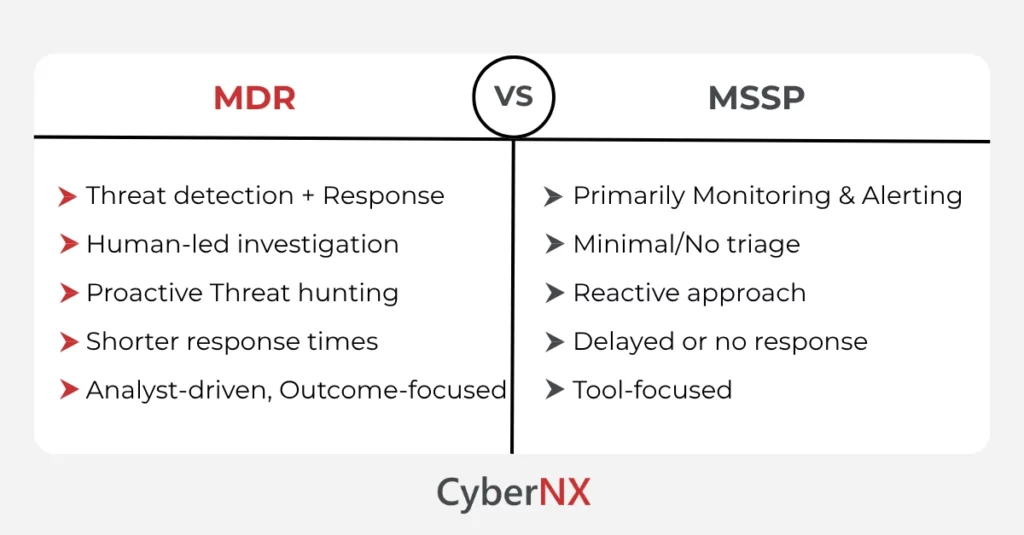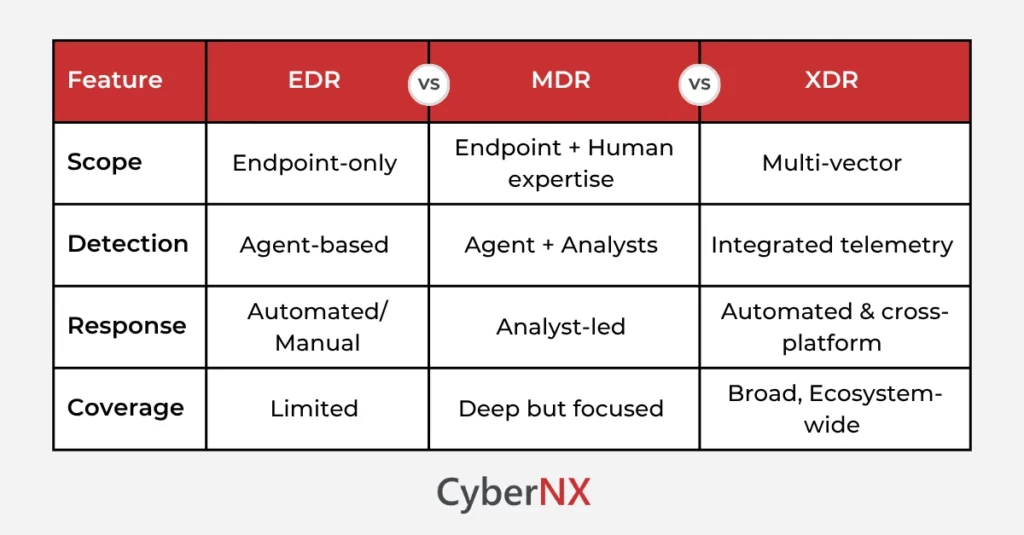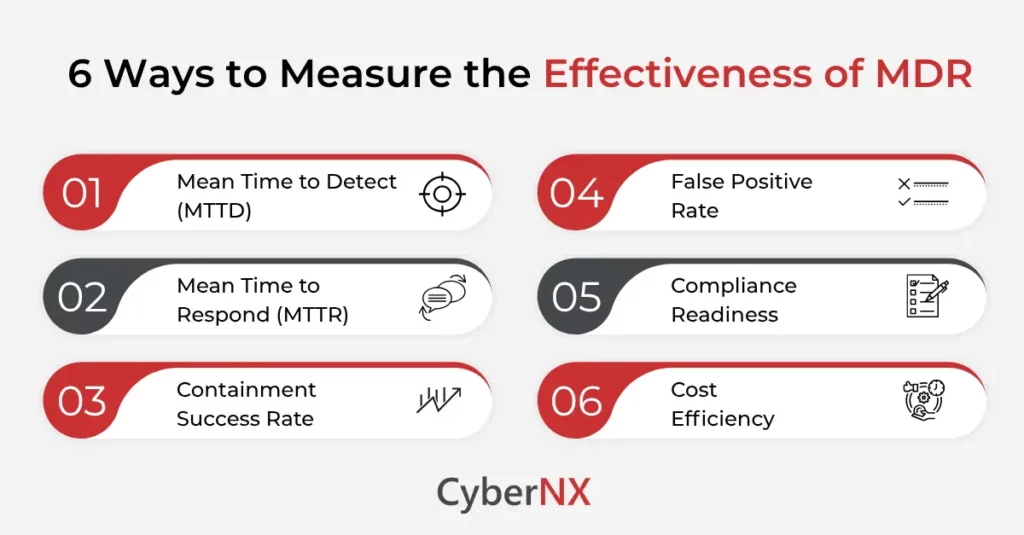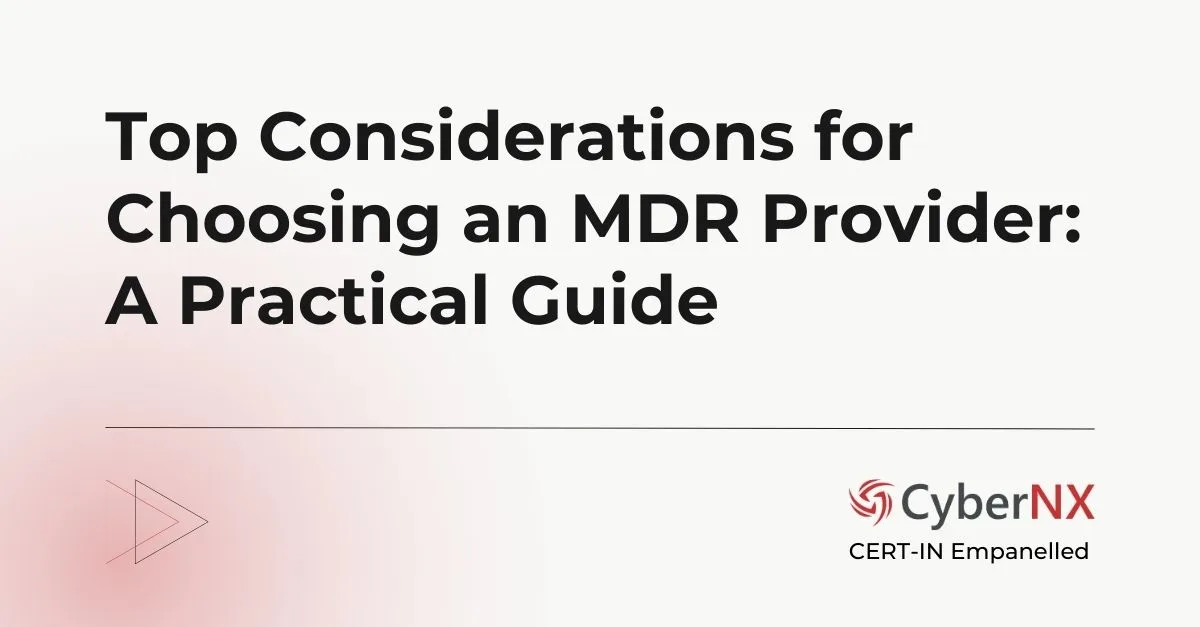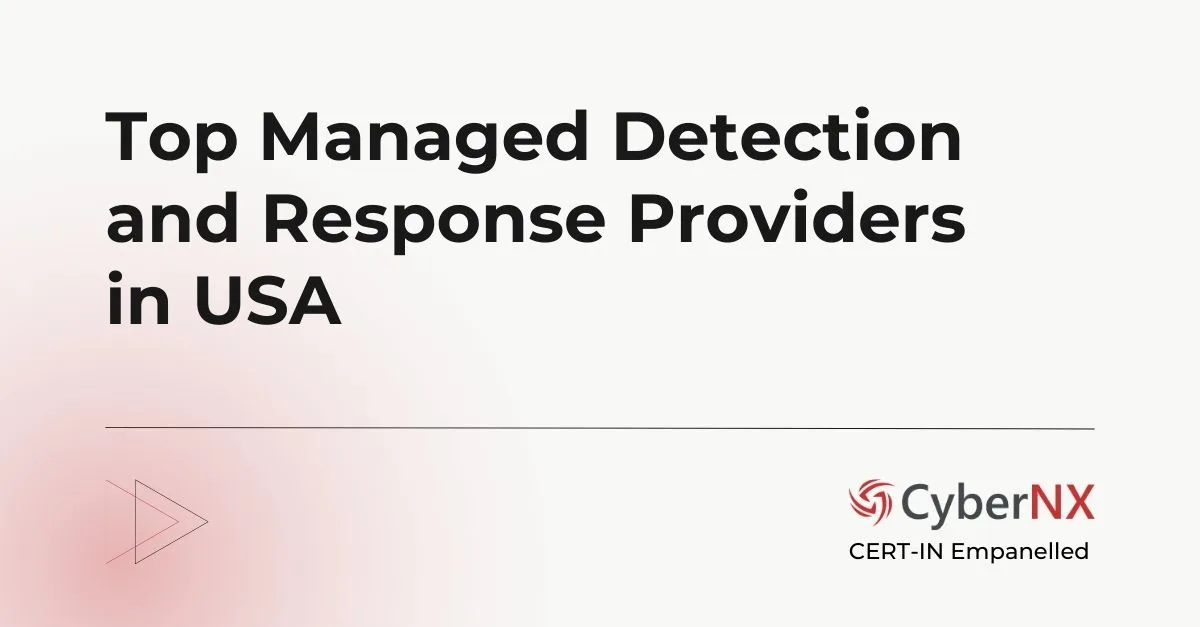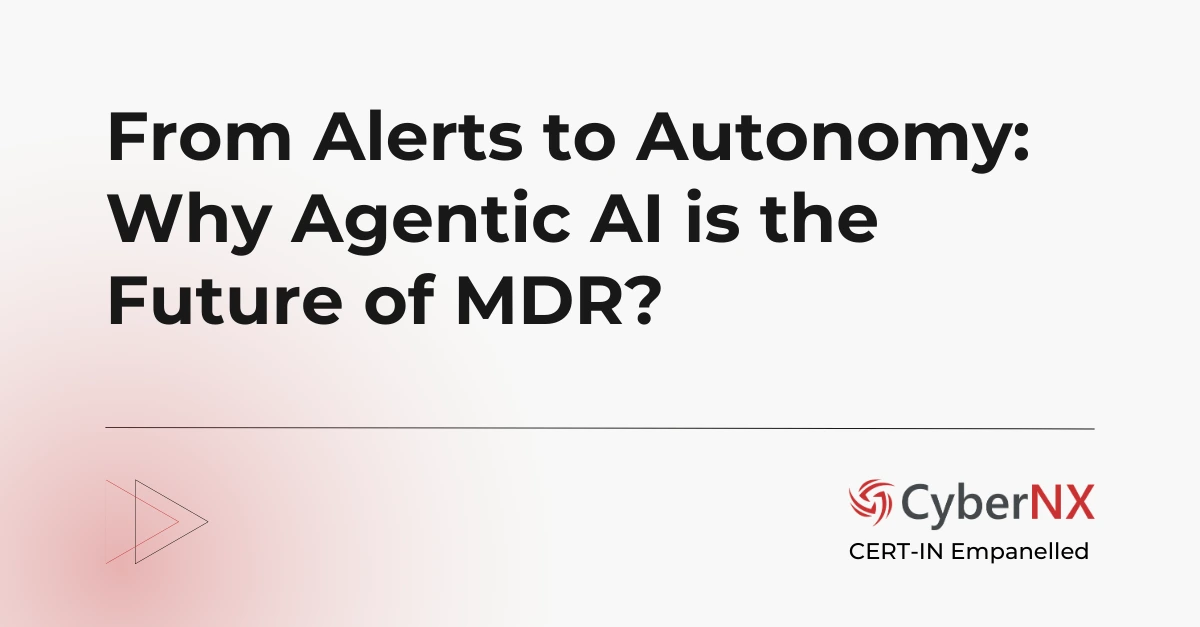Innovation powered by next-generation technologies has undoubtedly defined the past decade for businesses worldwide. However, beneath the shiny surface of the convenient and effective digital revolution lies a shadow: vulnerabilities.
Take for instance Artificial Intelligence (AI), cloud platforms and IoT devices – all of them era-defining technologies. But emerging security threats from these popular innovations have become like ticking time bombs. Dangerous enough to damage your businesses permanently.
So, what did security professionals on the right side of it do?
To tackle this mounting challenge, the cybersecurity industry birthed multiple advanced tools and complex technologies. But the result was a mess. Why? Because nobody knew what was best for their business. This is when Managed Detection and Response (MDR) exploded into the scene and became the way forward for those protecting businesses from evolving threats.
Still, many questions may come into your mind like – Is managed detection and response service just hype? or How does MDR help different industries? And why should my business invest in it? Fair questions.
In this managed detection and response guide, you will find everything you need to know about this cybersecurity service.
What is Managed Detection and Response?
Let’s begin by deciphering MDR if you don’t know already about it. Or maybe you have a brief idea, but it isn’t crystal clear.
By definition, MDR is a cybersecurity service that blends human expertise and advanced technology to perform primarily three things: threat detection/ hunting, continuous monitoring and analysis plus rapid response or remediation.
Unlike traditional security services, MDR’s comprehensive security offering covers networks, endpoints and cloud environments 24×7.
One of the biggest advantages is that MDR services proactively searches for threats, investigates and responds in real-time, thus reducing time-to-detect. Consequently, the threat impact on a business is vastly reduced, saving costs and reducing the need for resources.
3 Challenges MDR Solves for Your Business
There are challenges galore faced by the best of security teams at large organisations. MDR, with its high-end capabilities, acts as a great support system for in-house teams. Find out about 3 such challenges, where MDR comes as a pressure release valve for businesses.
1. Alert Fatigue
Let’s be honest here; security teams do get overwhelmed by constant alerts. Why? Because security tools generate thousands of alerts daily. And many turns out to be false positives or lack proper context. This noise could drown dangerous threats, and analyst could end up missing them.
Managed Detection and Response emerges as a solution, a relief as it filters and validates alerts, ensuring only true threats are escalated.
2. Shortage of Skilled Professionals
There are cybersecurity professionals. But are they skilled enough to tackle the evolving threat landscape? Probably not. This impacts mid-sized businesses the most, and they find it hard to hire and retain talent who can handle threats effectively. MDR offers access to experienced security analysts, plugging this gap.
3. Catching Advanced Threats
Advanced threats like fileless malware and supply chain could easily trick traditional security tools and bypass them. MDR uses proactive threat hunting, behavioural analytics and real-time intelligence to identify such threats early and stop them.
Key Benefits of Managed Detection and Response
Think of managed detection and response as an emergency service. Always watching, always ready. Such systems make detecting threats easier today.
The system can identify and understand how the threats detected could impact your business and what are the ways to deal with them. In addition, timely action differentiates managed detection and response from other services.
Here are some of the other benefits:
1. Threat Hunting & Analysis
It is almost impossible for a company to detect every security event with the existing technology stack. In such a scenario, MDR’s proactive method helps in identifying active attacks and taking necessary actions to neutralize them.
Interpreting alerts as a threat is not a walk in the park. MDR utilizes experienced experts, advanced analytics and threat intelligence to understand the alerts and suggest improvements.
2. Expert Access
Skills gap and lack of professionals are perennial issues plaguing the cybersecurity industry. Companies offering Managed Detection and Response services provide access to experts who function 24×7 and offer consultation whenever necessary.
24×7 Monitoring Round the clock monitoring and threat detection is a major benefit offered by managed detection and response services. This holistic approach always ensures heightened level of protection against all possible threats.
3. Alert Management
The high volume of cybersecurity alerts, most often false, is a big challenge for a business. Security teams often end up feeling alert fatigue while checking each of the alerts. Managed Detection and Response services can take up this tedious task and prevent businesses from possible threats.
4. Fast Incident Response
Security professionals working in the MDR department are capable of identifying any sort of unusual activities, detecting threats quickly and following mitigation procedures in the shortest time, boosting incident response.
How MDR Works? A Step-By-Step Process
Managed Detection and Response guide combines people, process and technology to detect, analyse and respond to advanced threats. Here’s how it works:
1. Monitoring
As part of the first step, advanced tools like telemetry from EDR, SIEM, network traffic and cloud environments are used to continuously monitor the systems, networks and endpoints for any malicious activity.
2. Threat Detection & Hunting
Malicious activities are detected using machine learning, behavioural analytics and threat intelligence feeds. The MDR experts proactively examine the alerts for hidden threats automated tools may miss.
3. Analysis
This step involves a thorough investigation of real and false alerts. Expert-led triage offers deep context around attack vectors, affected assets and MITRE ATT&CK mapping. Each incident is analysed, potential effects derived, and possible action plan prepared.
4. Threat Response
The security team behind the scenes notify the business about incidents and recommend the best course of action to resolve the problem. This may include guidance or execution of containment, eradication or recovery actions.
5. Remediation
Event triage is undertaken where the security team lists events/incidents in the order of immediate attention required. This is followed by recovery actions to eliminate threats, restore affected systems and further study the problem to prevent future occurrences.
6. Compliance
MDR plays a crucial role in helping organizations achieve and maintain compliance standards with automated reporting.
Is there an MDR framework?
Yes. The MDR framework revolves around technology, tools, SOC and other core components. More about it below:
1. Data Collection
MDR experts collect data from endpoint logs, network traffic, cloud infrastructure and identity services. This data is then fed into centralized systems, which acts as a foundation for further detection and analysis.
2. Analytics & Detection Engine
Advanced analytics engines use a combination of AI, ML and behaviour-based rules to detect anomalies and indicators of compromise. This engine helps identify threats that may bypass signature-based defences.
3. Threat Intelligence & Enrichment
Context is the key to know a harmless anomaly from a real threat. So, threat intelligence feeds are set to provide that context by correlating internal telemetry with known indicators of attack. Enrichment layers also help experts validate alerts and guide response decisions.
4. Security Operations Centre (SOC)
The role of SOC is crucial. Expert human analysts continuously monitor for threats, investigate suspicious behaviour and escalate critical incidents. Teams work 24X7 to ensure timely detection and response.
5. Response & Remediation
Managed Detection and Response (MDR), as you can see in the name, does not stop at detection. It involves response. This, MDR delivers guided or fully managed response capabilities, from quarantining endpoints and revoking compromised credentials to ensuring threats are contained quickly and efficiently.
6. Reporting
Transparent reporting helps stakeholders to understand security posture, track KPIs like MTTD and MTTR and show compliance with key industry regulations.
Managed Detection and Response: What About Tools?
For the uninformed, there are hundreds of tools out there in the market worldwide. Some of the world leaders in cybersecurity offer in-house built tools for top-notch security.
Here, we intend to discuss about the tools in a general way. Find out:
Endpoint Detection and Response (EDR)
EDR tools help in monitoring endpoint activity in real time. It proactively captures behavioural signals that assist in identifying threats such as ransomware, malware or privilege escalation.
Network Detection and Response (NDR)
NDR tools analyse east-west and north-south network traffic to detect unusual communications, lateral movement, and data exfiltration.
Security Information and Event Management (SIEM)
SIEM platforms collect and correlate log data from across the IT environment.
Security Orchestration, Automation, and Response (SOAR)
SOAR tools automate incident response workflows, reducing manual effort and speeding up resolution times.
Threat Intelligence Platforms
Threat intelligence adds context by feeding external threat data into the detection engine.
If you want to know more about the tools, read our blog post on MDR Tools: The Top 10 Platforms to Know in 2025.
Comparisons: MDR vs Other Cybersecurity Services
Explore how MDR stacks up against other cybersecurity services. Below, we break down key differences like MDR vs MSSP, EDR, and more to help you choose the right solution.
1. MDR vs MSSP
MDR (Managed Detection and Response) and MSSP (Managed Security Service Provider) may seem similar but serve different security functions. The comparison chart below highlights their core differences in scope, approach, and value delivery.
This is, of course, only a preview into their differences. To unearth more details, read our blog MDR vs MSSP.
2. MDR vs MXDR
Managed Detection and Response is limited to endpoints and log telemetry, whereas MXDR (Managed Extended Detection and Response) expands this to include network, email, identity and cloud security telemetry, offering a more holistic view.
3. EDR vs MDR vs XDR
EDR, MDR, and XDR are all threat detection and response solutions, but they differ in coverage, complexity, and capabilities. The chart below breaks down their key distinctions to help you choose the right fit for your security needs.
Explore the differences in detail with our blog: EDR vs MDR vs XDR.
4. MDR vs SOC (Security Operations Centre)
SOC can be understood as an internal team, often with a high-cost and resource-intensive. In comparison, Managed Detection and Response(MDR) is outsourced, more affordable and expert driven.
For detailed information, read our blog MDR vs SOC.
5. MDR vs SIEM
SIEM is a tool for data aggregation and correlation, and MDR is a service that leverages tools like SIEM but includes active response and human expertise.
Do You Need MDR Services? Find the Answer
That’s a tricky question because of the many factors involved. And the answer might lie with you. This is because only you know the business and its requirements. So, here we are doing a bit of generalization and informing who needs Managed Detection and Response services.
Small to Mid-Sized Businesses
Having an in-house SOC for SMBs could prove to be costly. That’s where Managed Detection and Response helps. It provides monitoring and response services under experts eliminating the cost and complexity of hiring a large team.
Highly Regulated Industries
Healthcare, finance and energy – these are few industries with strict compliance requirements and higher risk levels. MDR helps these companies overcome the regulatory challenges. Plus, it ensures fast response to threats.
Cloud-First or Remote Workplaces
If you are relying on a remote workforce and cloud-native infra, you need to urgently secure operations across boundaries. MDR is of great help here as it enables complete visibility across endpoints, SaaS platforms and cloud workloads.
Overburdened Security Teams
Companies experience alert fatigue as discussed before. They can rely on MDR to reduce the workload. Additionally, it allows internal teams to focus on important projects while MDR teams handle detection and response.
Vertical-Specific MDR Compliance
Different industries have to deal with different compliance mandates and attack vectors. Managed Detection and Response service providers tailor services that include threat detection and align with compliance, offering sector-specific needs.
For example – in healthcare industry, Managed Detection and Response (MDR) supports HIPAA requirements by monitoring patient data systems and detecting ransomware targeting EHRs. For energy and utilities, MDR maps to NERC-CIP protocols and detects ICS/SCADA-related anomalies. These sector-focused MDR solutions ensure alignment with both regulatory requirements and operational realities.
Key Considerations When Choosing an MDR Service Provider
Selecting the right MDR provider requires evaluating the threat detection capabilities, response time and technology stack. It is also essential to assess their industry experience, compliance support and ability to integrate with your existing security infrastructure.
Telemetry Coverage
Choose a MDR provider who supports multiple data sources, from endpoint and cloud to identity and network. This gives you full visibility into your environment and prevent advanced attacks.
Threat Response
Not all MDR service providers offer hands-on remediation. Thus, it is important to ask if the provider offers active response services or just alerting and advice services.
Speed and SLAs
Faster the detection and response to incidents, better and secure is your business. So, you should know SLAs for response time, especially for critical alerts.
Analyst Expertise and Availability
This goes without saying- always check background and certifications. You would want experienced MDR professionals to handle investigations and available 24X7X365.
Integration Capabilities
This is important – choose MDR solutions that integrate with your current set of tools. What seamless integrations does is that it will reduce probable operational friction and speed up onboarding process.
Reporting and Compliance
Meeting regulatory requirement and compliance is the top of the list priority for businesses. So, make sure that MDR service provider supports compliance with GDPR, HIPAA, PCI-DSS and others. Plus, they include audit trails and custom reports.
Pricing and Contracts
Learn how the MDR provider charges. Some charge per endpoint, event or based on outcomes. Transparent pricing is key for long-term collaboration and ROI.
Industry Expertise
It is true that MDR service providers with proven expertise and experience in your industry will understand your risks and compliance requirements better.
Implementing MDR with Your In-House Team
It is all about seamless collaboration between your in-house team and the MDR experts. How can your business achieve this objective?
So, first start by defining – Who handles containment? Who communicates with stakeholders? A RACI matrix can streamline this process.
Next up, deploy all the telemetry tools and integrate them into the security ecosystem. This might include installing EDR agents, connecting cloud logs or configuring identity providers to send authentication events.
Working together to create response playbooks is the way to go. These documents ensure that incidents are handled in a consistent, predictable manner and that escalation paths are well understood.
Include tabletop exercises to simulate real-world scenarios. This helps both internal and MDR teams prepare for real incidents and identifies gaps in playbooks or processes.
Finally, you can set up a feedback loop where lessons learned from incidents inform policy updates, user awareness training and tool configurations.
The Impact of MDR on Businesses
As companies often have their hands full, MDR acts as a panacea, a blessing, a boon, impacting businesses in terms of performance, resilience, risk management and reputation.
Less Cyber Risk
Due to the proactive nature of MDR, threats are identified and neutralized before they spiral out of control and cause financial loss, minimizing cyber risks.
Cost Savings
The average cost of a data breach is nothing less than a million. Continuous protection and reduced time-to-detect and response reduces costs.
Scalability
MDR is scalable according to the growing needs of the organization, technological advancements and evolving threats.
Brand Reputation
MDR is more business-centric, helping businesses to prevent brand reputation by protecting data and building trust.
History has shown that those who don’t adapt will fall behind. Jump on the bandwagon and achieve better security and return on investments with Managed Detection & Response service.
Conclusion
New technologies are critical to success. It is high time C-level executives, IT managers and cybersecurity departments embrace Managed Detection & Response strengthening their security processes.
Given the rising and sophisticated challenges in the cybersecurity industry, Managed Detection and Response is a powerful service that provides you with an edge over cybercriminals and threat actors. Combine the potential of MDR with your security team, and it can open endless opportunities for security, growth and success.
CyberNX has extensive experience in offering Managed Detection and Response for businesses in India and across the globe. Transform your security processes with us while focusing on delivering high value to your customers/clients with confidence.
Count on our team of experts for seamless integration of MDR into your cybersecurity process. Contact us today for MDR services.
Managed Detection and Response FAQs
How is MDR different from just having an in-house security team or a SIEM solution?
While in-house teams and SIEMs play crucial roles, Managed Detection and Response brings together people, process and technology to provide continuous threat hunting, real-time detection and hands-on response. Unlike SIEMs that primarily collect and alert on logs, MDR services offer expert-led investigations, proactive threat hunting and direct containment actions. It’s not just about spotting alerts, it’s about resolving them before they cause damage with 24/7 coverage that most internal teams cannot sustain on their own.
Can MDR integrate with the tools I already use or will I have to replace my current security stack?
Most modern Managed Detection and Response – MDR providers are built to integrate seamlessly with your existing tools like EDR, SIEM, identity providers and cloud platforms. Instead of replacing your stack, MDR enhances it by connecting the dots across multiple telemetry sources and layering in advanced analytics and expert intervention. Integration ensures faster onboarding and lowers operational disruption while preserving your existing investments in cybersecurity infrastructure.
What kind of businesses actually need MDR services? Is it only for large enterprises?
MDR is not just for Fortune 500 companies. In fact, small to mid-sized businesses often benefit the most as they typically lack the resources to maintain a 24/7 SOC or hire specialized threat analysts. Any business that handles sensitive data, operates in a regulated industry or cannot afford prolonged downtime due to a cyberattack should consider MDR. It is a scalable and cost-effective way to gain enterprise-grade threat detection and response without building everything in-house.
How quickly can I expect MDR to respond in the event of a security incident?
Response times can vary depending on the provider but leading MDR services offer clearly defined SLAs for both detection and response, often committing to alert and act within minutes of identifying a critical threat. The best MDR teams do not just notify you, they actively engage in containment, provide real-time remediation guidance and keep you informed throughout the process. Fast and decisive action is one of the core benefits of a mature MDR offering.


